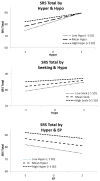National survey of sensory features in children with ASD: factor structure of the sensory experience questionnaire (3.0)
- PMID: 24097141
- PMCID: PMC3949144
- DOI: 10.1007/s10803-013-1945-1
National survey of sensory features in children with ASD: factor structure of the sensory experience questionnaire (3.0)
Abstract
This national online survey study characterized sensory features in 1,307 children with autism spectrum disorder (ASD) ages 2-12 years using the Sensory Experiences Questionnaire Version 3.0 (SEQ-3.0). Using the SEQ-3.0, a confirmatory factor analytic model with four substantive factors of hypothesized sensory response patterns (i.e., hyporesponsiveness; hyperresponsiveness; sensory interests, repetitions and seeking behaviors; enhanced perception), five method factors of sensory modalities (i.e., auditory, visual, tactile, gustatory/olfactory, vestibular/proprioceptive), and one of social context were tested with good model fit. Child and family characteristics associated with the sensory response patterns were explored. The effect of sensory response patterns on autism severity was tested, controlling for key child and family characteristics. The SEQ-3.0 demonstrates an empirically valid factor structure specific to ASD that considers sensory response patterns, modalities, and social context.
Figures
References
-
- American Psychiatric Association. Proposed Autism spectrum disorder. 2012 Retrieved from http://www.dsm5.org/proposedrevisions/pages/proposedrevision.aspx?rid=94.
-
- American Psychiatric Association. Diagnostic and statistical manual of mental disorders. 4. Washington, DC: American Psychiatric Publishing, Inc; 2000. text rev.
-
- Baio J. Prevalence of autism spectrum disorders–autism and developmental disabilities monitoring network, 14 sites, United States, 2008. Centers for Disease Control and Prevention Surveillance Summaries. 2012;61(3):1–19. Retrieved from http://www.cdc.gov/mmwr/pdf/ss/ss6103.pdf. - PubMed
-
- Baranek GT. Sensory experiences questionnaire version 3.0. 2009. Unpublished manuscript.
-
- Baranek GT, David FJ, Poe MD, Stone WL, Watson LR. Sensory experiences questionnaire: Discriminating sensory features in young children with autism, developmental delays, and typical development. Journal of Child Psychology and Psychiatry. 2006;47(6):591–601. doi: 10.1111/j.1469-7610.2005.01546.x. - DOI - PubMed
Publication types
MeSH terms
Grants and funding
LinkOut - more resources
Full Text Sources
Other Literature Sources




